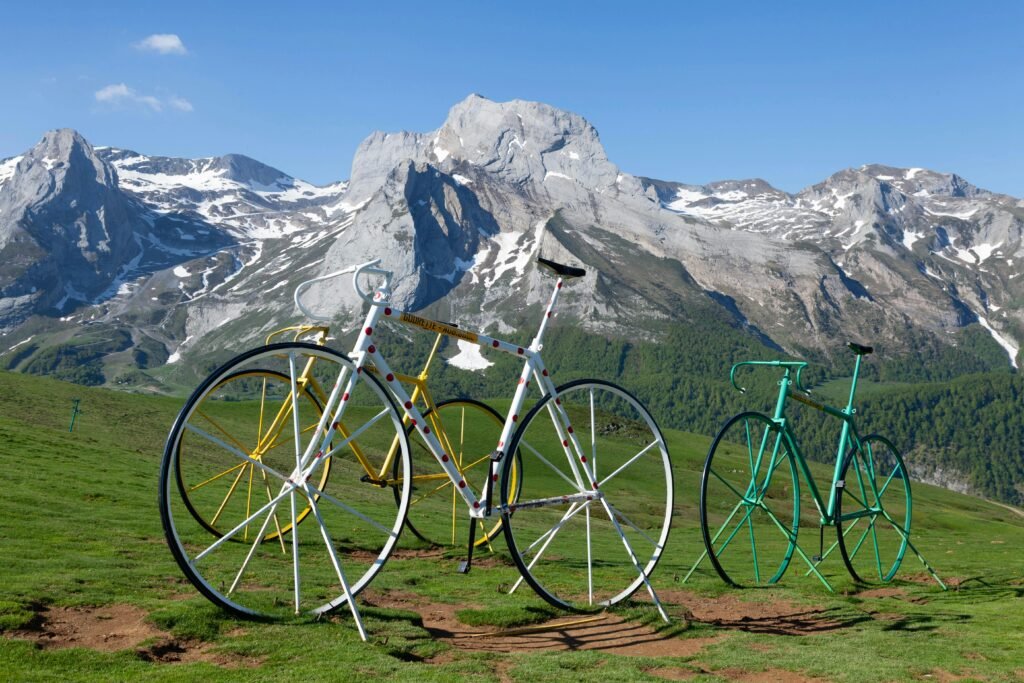You know that exhilarating feeling of riding your off-road bike through muddy trails and challenging terrains. But after a thrilling adventure, your beloved bike is left covered in dirt, grime, and grit. Fear not, because this article is here to guide you through the ultimate cleaning process for off-road bikes. With these essential cleaning tips, you’ll be able to restore your bike’s shine, keep it in the best condition, and ensure an optimal off-road riding experience every time. So grab your cleaning supplies, put on some friendly tunes, and let’s get that bike sparkling clean!

This image is property of images.pexels.com.
Choosing the Right Cleaning Supplies
When it comes to cleaning off-road bikes, selecting the right cleaning supplies is crucial. Choosing the appropriate products will ensure that you effectively clean your bike without causing any damage. One important cleaning supply to consider is the bike cleaner. There are various options available on the market, so it’s important to choose one that is specifically designed for bikes. Look for a bike cleaner that is formulated to remove dirt, grime, and mud without harming the bike’s paint or finish.
In addition to bike cleaner, it’s important to choose non-corrosive degreasers. The drivetrain of your bike can accumulate a lot of grease and grime, so using a degreaser is essential for proper maintenance. Opt for degreasers that are specifically designed for bikes and are non-corrosive, as they will effectively remove grease buildup without damaging your bike’s components.
When it comes to cleaning your bike, using soft brushes and sponges is key. Hard bristle brushes can potentially scratch your bike’s frame and components, so it’s always best to opt for softer brushes. Look for brushes made specifically for bike cleaning, as they are designed to effectively remove dirt and grime without causing any damage.
Another important cleaning supply to consider is the cleaning solvent. Cleaning solvents can be used for removing tough grease and grime from your bike’s components. When choosing a cleaning solvent, make sure to select one that is safe to use on bike parts and won’t cause any damage or corrosion.
Lastly, if you want to achieve an even deeper clean, consider purchasing a pressure washer. A pressure washer can effectively remove stubborn dirt and grime from your bike, especially in hard-to-reach areas. But be cautious when using a pressure washer, as using too high pressure can damage your bike’s paint and components. Always follow the manufacturer’s instructions and use a low-pressure setting to avoid any potential damage.
Preparing the Bike for Cleaning
Before you start cleaning your bike, it’s important to properly prepare it. This will ensure that you have a smooth and effective cleaning process. Start by removing any accessories from your bike, such as lights, water bottles, and bike bags. This will prevent them from getting wet or damaged during the cleaning process.
Next, secure any loose parts on your bike. Make sure that all screws, nuts, and bolts are properly tightened to avoid any accidents or damage.
Thoroughly inspect your bike before cleaning. Check for any signs of damage, such as cracks or dents on the frame, loose cables, or worn-out components. Taking note of any damage before cleaning will help you address any issues during the maintenance process.
Checking the tire pressure is another important step in preparing your bike for cleaning. Make sure your tires are properly inflated to the recommended PSI. This will not only make your bike easier to clean but will also ensure optimal performance when you hit the trails again.
Lastly, before you start cleaning, remove any excess dirt and mud from your bike. You can use a brush or a low-pressure hose to get rid of large chunks of dirt. This will make the cleaning process more effective and prevent the dirt from spreading while you clean different parts of your bike.
Cleaning the Frame and Fork
Once you’ve properly prepared your bike, it’s time to start the cleaning process. Begin by using mild soap and warm water to clean the frame and fork. Avoid using strong detergents or harsh chemicals, as they can damage the paint or finish of your bike. Instead, opt for a gentle soap or bike-specific cleaner.
Apply the bike cleaner to the frame and fork, focusing on areas with heavy dirt or grime buildup. Use a soft brush to gently scrub the surfaces, removing any stubborn dirt. Be sure to scrub gently to avoid scratching or damaging the bike’s paint.
After scrubbing, rinse off the soap thoroughly with clean water. Make sure to remove all traces of the soap to prevent any potential damage or residue.
Once the frame and fork are clean, dry them off with a clean towel. Make sure to remove all excess water to prevent any potential rust or water damage. Pay special attention to areas where water can accumulate, such as inside the frame or around the bottom bracket.
Degreasing the Drivetrain
Cleaning the drivetrain is an important part of bike maintenance, as it helps to ensure smooth shifting and optimal performance. Start by applying a non-corrosive degreaser to the chain. Make sure to carefully follow the instructions provided by the manufacturer.
Use a chain brush to thoroughly clean the chain, removing any built-up dirt or grease. Scrub the chain in a back and forth motion, making sure to cover all sides. This will help to remove any dirt or grime that has accumulated between the links.
Next, clean the cassette and chainrings. Use a clean rag or a brush to remove any excess degreaser and dirt. Make sure to wipe each tooth of the cassette and chainrings to get rid of any debris.
After cleaning, make sure to rinse off the degreaser completely with clean water. This step is important to prevent any degreaser residue from causing damage or attracting dirt. Once rinsed, dry the drivetrain with a clean towel.
To ensure smooth operation, apply a bike-specific lubricant to the chain. Make sure to use a lubricant that is appropriate for your riding conditions and follow the manufacturer’s instructions for application.

This image is property of images.pexels.com.
Cleaning the Wheels and Tires
Properly cleaning your bike’s wheels and tires is essential for optimal performance and longevity. Start by removing the wheels from your bike to make the cleaning process easier. This will allow you to thoroughly clean both the wheels and the tires.
Using a wheel brush or sponge, clean the rims and spokes of the wheels. Pay special attention to any dirt or grime buildup, as it can affect the braking performance and overall functionality of your bike.
Inspect the tires for any signs of damage, such as cuts or punctures. It’s important to address any issues with the tires before hitting the trails again to prevent flats or accidents.
Once the wheels and tires are clean and inspected, reinstall them properly onto your bike. Make sure to secure them tightly and double-check that they are aligned correctly.
Cleaning the Brakes and Rotors
Properly cleaning your bike’s brakes and rotors is essential for optimal stopping power and safety. Start by wiping down the brake levers and handles with a clean rag. This will remove any dirt or oil buildup that can affect the brake performance.
Next, clean the brake calipers using a brush or a clean rag. Make sure to remove any debris or dirt that may have accumulated around the brake calipers.
Inspect the brake pads for any signs of wear or damage. If the brake pads are worn down or damaged, it’s important to replace them before riding.
To clean the rotors, use a clean rag or a specialized rotor cleaner to remove any debris or dirt. Make sure to remove any loose particles that may affect the braking performance.
After cleaning, it’s important to check the brake performance. Squeeze the brake levers and ensure that they engage smoothly and bring the bike to a stop. If you notice any slipping or lack of braking power, it may be necessary to further inspect and adjust the brakes.

This image is property of images.pexels.com.
Cleaning the Suspension Components
For bikes with suspension components, proper cleaning and maintenance are crucial to ensure optimal performance and longevity. Start by protecting the suspension seals and bearings from water and cleaning agents. Use a plastic bag or specially designed covers to prevent any potential damage or contamination.
Next, use a suspension-specific cleaner to clean the stanchions and dust seals. Avoid using any harsh chemicals or abrasive materials, as they can damage the suspension components. Instead, opt for a cleaner that is specifically designed for suspension systems.
Gently scrub the stanchions and dust seals using a soft brush or sponge. Make sure to remove any dirt, mud, or debris that may have accumulated on these parts. This will help to ensure smooth operation and prevent premature wear.
After cleaning, carefully inspect the suspension components for any signs of damage, such as leaks or cracks. If you notice any issues, it’s important to address them before riding.
If necessary, apply a suspension lubricant to the stanchions and dust seals. This will help to maintain smooth operation and prevent premature wear. Make sure to follow the manufacturer’s instructions for lubricant application.
Maintaining and Cleaning the Chain
The chain is an essential part of your bike’s drivetrain, and proper maintenance is crucial for optimal performance and longevity. If your chain is heavily soiled or worn, it may be necessary to remove it for a more thorough cleaning.
To clean the chain, use a chain cleaner or degreaser. These specialized tools are designed to effectively remove grease and dirt from the chain. Follow the instructions provided with the chain cleaner to ensure proper use.
Using a brush, scrub the chain thoroughly to remove any old lubricant or dirt. Make sure to clean all sides of the chain to ensure a deep clean.
After cleaning, make sure to dry the chain thoroughly with a clean towel. Excess moisture can lead to rust or corrosion, so it’s important to remove all water from the chain.
Once the chain is dry, apply a bike-specific lubricant. Proper lubrication will ensure smooth shifting and reduce wear on the chain and drivetrain components. Make sure to apply the lubricant evenly and wipe off any excess to prevent attracting dirt and grime.
While cleaning the chain, it’s also a good time to check for chain wear and tension. If the chain is stretched or worn, it may be time for a replacement. A proper chain tension is important for efficient power transfer and smooth shifting.
Cleaning the Pedals and Cleats
The pedals and cleats on your off-road bike can accumulate a lot of dirt and debris. Properly cleaning them is essential for optimal performance and safety.
To make the cleaning process easier, remove the pedals from your bike. This will allow you to thoroughly clean both the pedals and the cleats.
Using a brush and soapy water, clean the pedals to remove any dirt or grime. Pay special attention to the areas where the cleats attach to the pedals, as dirt buildup in these areas can affect engagement and release.
Similarly, clean the cleats using the brush and soapy water. Make sure to remove any dirt or debris that may have accumulated, as it can affect the engagement and release of the cleats.
Inspect the pedals and cleats for any signs of wear or damage. If you notice any issues, such as worn-out pedal threads or damaged cleat engagement mechanisms, it may be necessary to replace them.
Before reinstalling the pedals, make sure to grease the pedal threads. This will ensure smooth installation and removal in the future. Use a bike-specific grease and apply it evenly to the pedal threads.
Properly Storing the Cleaned Bike
Once you have cleaned and maintained your off-road bike, it’s important to properly store it to ensure its longevity and keep it in top condition.
Firstly, make sure to dry the bike completely after cleaning. Remove any excess water or moisture using a clean towel. This step is crucial to prevent any potential rust or water damage.
Applying corrosion protection is another important step in storing your bike. Use a bike-specific corrosion protection spray or wax to coat the frame and other metal components. This will help to prevent rust and corrosion during storage.
Covering the bike with a bike cover or a clean sheet can help to prevent dust and dirt from settling on it. This is especially important if you don’t have a dedicated storage space for your bike.
Storing your bike in a dry and secure location is crucial to prevent any potential damage. Moisture and extreme temperatures can cause harm to your bike, so it’s important to find a space that is cool, dry, and free from any potential hazards.
Lastly, performing regular maintenance checks is essential to keep your bike in top condition. Regularly inspect your bike for any signs of wear or damage, and address any issues promptly. Keep up with regular maintenance tasks, such as lubricating the chain and checking tire pressure, to ensure optimal performance.
By following these essential cleaning tips for off-road bikes, you can keep your bike in top-notch condition for all your adventures on the trails. Regular cleaning and maintenance will not only help to extend the lifespan of your bike but will also ensure optimal performance and safety during your rides. So grab your cleaning supplies and give your off-road bike the care it deserves!
